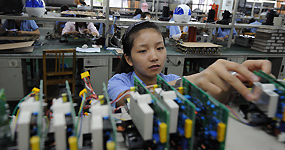Others Glass Bottles, Mountain Bottom750ml Empty Glass Bottle with Cork Lid, China Others Glass Bottles Glass Vase,Candle Holder Co., Ltd. , http://www.housewarecrafts.com The British "Financial Times" Rahul Jacobs Hong Kong reported that China may be a world-famous factory, but as manufacturing companies shift production lines to lower-cost countries, a Hong Kong underwear manufacturer finds Thailand more attractive. .
The British "Financial Times" Rahul Jacobs Hong Kong reported that China may be a world-famous factory, but as manufacturing companies shift production lines to lower-cost countries, a Hong Kong underwear manufacturer finds Thailand more attractive. .
Top Form International has been supplying Walmart and other companies from the company's South China factory. But as workers demand more and more wages, the company is forced to face China's new reality.
Julius CFO Michael? Michael Austin, sitting in a Hong Kong office across the border from Guangdong province, said that the company found that wages rose by 20% every year. "China's policy is to double wages in five years, and we estimate that it will be faster than that."
Shenzhen, a special economic zone adjacent to Hong Kong, raised the minimum wage from 1,100 yuan ($172) to 1,320 yuan in April this year. The company then accelerated its plan to cut the number of sewing workers, which was reduced from 1,000 people a few years ago. 400 people. After a series of suicides by electronics manufacturer Foxconn, the Chinese government has also raised manufacturing wages nationwide.
However, the greater challenge faced by Julis is the change in China's demographic structure. There are fewer and fewer young workers joining the labor force every year. Due to the one-child policy and the general preference for boys, the practice of selective abortion of female fetuses has produced an anomalous phenomenon: fewer and fewer female workers are working in factories. Business owners in South China reported that the ratio of men to women in factory workers is now 60:40, whereas women used to dominate.
Last week, UBS economist Jonathan? Jonathan Anderson published a report after analyzing the import data of the United States and the European Union in the first half of 2011. He found that the share of China's light manufacturing industry began to decline, from the previous 50% to 48%. Beneficiaries include Bangladesh (which has increased exports to the United States by 19%) and Vietnam (16%).
When talking about shifting labor-intensive manufacturing to Southeast Asia, Anderson said that the first half of 2011 “appeared to be a very convincing turning pointâ€. He said that in contrast to this, India and the Philippines, which should have been the “natural destination†of labor-intensive investment, became spectators in the process.
For Guangdong Province, the province with the highest level of industrialization and wealthiest in China, the relocation of such low-income jobs is exactly in line with the provincial government's initiatives over the years. In the 12th Five-Year Plan, Guangdong Province reduced the economic growth target to 8% per year. Huang Huahua, governor of Guangdong Province, and the provincial party committee have repeatedly stressed the need to move polluting industries and strengthen the development of technology-intensive industries.
University of Hong Kong Business School Professor Michael? Michael Enright said that a provincial government actively seeks to bid farewell to early industrial development methods, which may be the first time in history. The goals of the Chinese government are also roughly the same, but it is more difficult to achieve this change at the national level because workers in inland provinces are not as skilled as workers in Guangdong Province.
To learn more about how low-end manufacturing industries such as clothing and footwear are evacuating South China at a rapid rate, the global sourcing company Li & Fung's half-year financial report released last month also provides guidance. Li & Fung purchases goods for Western retailers such as Wal-Mart and Toys R Us, covering everything from T-shirts and hooded jackets to furniture and beauty products.
The group of data disclosed by Li & Fung CEO Bruce Rockowitz actually indicates that the garment, furniture and footwear manufacturing industry will usher in a new world order. The company’s purchase value in Bangladesh, which has a market value of US$16 billion, has increased by 52%, while purchases from Turkey and Indonesia have also increased by 20% or more.
Roland Lee owns Hilford, a company that produces denim garments. In order to allow the company to maintain profitability in the fierce competition, he will reduce the scale of orders he undertakes to around 2,000. He also moved to the high-end market, adding custom products for customers such as Armani Exchange. Li Jingyi said that the fact that the price of cotton rose more than twice last year, coupled with rising wages of workers, has prompted competitors to move factories to India.
However, India's high waste rate of producing clothing made him a bit wary. Li Jingyi still puts production in Shenzhen. There is a 24-hour customs clearance here between Hong Kong and Hong Kong.
Similarly, Julius will continue to produce high-end lingerie and bras in Nanhai City, Guangdong Province, where workers are more productive. In the area known as the “garment capitalâ€, there are many suppliers around.
China's increasingly close to world-class infrastructure, higher productivity and huge population means that it will continue to occupy a far leading share in jeans, clothing and toy manufacturing, as revealed by Li Fung’s announcement last month. In the first half of this year, the production scale of Li & Fung suppliers in China increased by 30%, while more suppliers moved to lower-cost inland provinces. Leyu publicly queried and asked where the "next destination" of global manufacturing is. The answer is still China. Translator / He Li